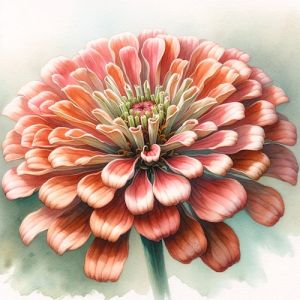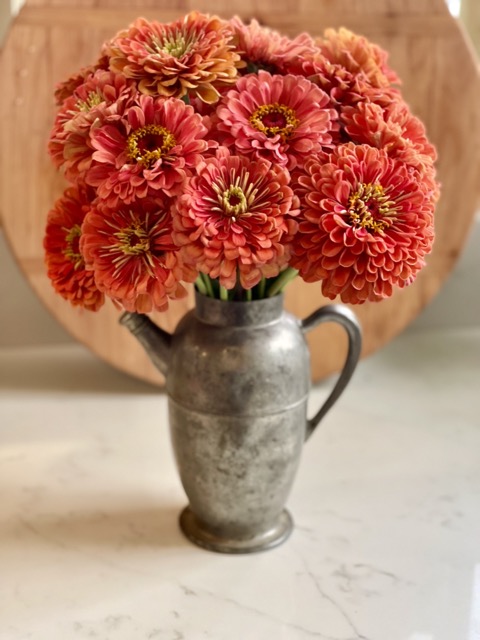Introduction to Zinnias
Embark on a colorful journey with our Zinnia garden guide. Zinnias, known for their vibrant and diverse blooms, are a delight in any garden. Easy to grow and maintain, they’re perfect for novice gardeners and a staple for the experienced. This guide covers all aspects of growing Zinnias, from selection to care, ensuring a bright display in your garden.
Botanical Overview
Understanding Zinnia’s Botanical Background
- Common Name: Zinnia
- Scientific Name: Zinnia spp.
- Family: Asteraceae Zinnias, part of the sunflower tribe within the daisy family, boast a wide range of bright and bold colors. Their straightforward growing requirements make them a popular choice for gardeners worldwide.
Zinnia Planting Zones
Understanding the ideal planting zones for Zinnias is key to ensuring these colorful flowers thrive in your garden. Zinnias are warm-weather plants, and their growing success largely depends on the climate and temperature of the area.
Zone Suitability
- Optimal Hardiness Zones: Zinnias grow best in USDA Hardiness Zones 3 through 10. They are annuals, meaning they complete their life cycle in one growing season.
- Warm Climates: In warmer climates, Zones 7 to 10, Zinnias can be planted early and will continue to bloom until the first frost.
- Cooler Climates: In cooler climates, particularly Zones 3 to 6, it’s best to plant Zinnias after the danger of frost has passed, usually late spring or early summer.
Climate Considerations
- Heat Tolerance: Zinnias are heat-tolerant and thrive in hot, sunny conditions, making them excellent for summer gardens.
- Frost Sensitivity: Being sensitive to frost, they should be planted after the last expected frost date in your area.
- Long Growing Season: In areas with a long growing season, Zinnias can provide continuous color from summer through the first frost.
Microclimates and Local Conditions
- Microclimates in Your Garden: Be aware of microclimates that might affect your Zinnias. Areas near walls, fences, or in open sun may be warmer and suitable for earlier planting.
- Soil and Watering: While Zinnias are adaptable to various soil types, they prefer well-draining soil. Regular watering, especially in dry conditions, will keep them vibrant.
By choosing the right planting time based on your specific zone and providing proper care, Zinnias can be a spectacular addition to your garden, offering a palette of colors throughout the growing season. Consulting with local nurseries or extension services can provide additional guidance tailored to your area’s specific climate conditions.
Varieties of Zinnia
Exploring the Diverse Varieties of Zinnias
- Zinnia elegans (Common Zinnia): Perhaps the most popular species, known for its wide range of colors and large, showy blooms.
- Zinnia angustifolia (Narrow-leaf Zinnia): Characterized by its smaller, more drought-tolerant flowers and narrower leaves.
- Zinnia marylandica: A hybrid between Zinnia elegans and Zinnia angustifolia, known for its disease resistance and compact growth.
- Zinnia haageana (Mexican Zinnia): Offers unique bicolored petals and a more compact growth habit.
- Zinnia acerosa (Desert Zinnia): A hardy variety adapted to arid environments, producing white to yellowish flowers.
- Zinnia peruviana (Peruvian Zinnia): Distinguished by its red-orange flowers, it’s a less common species offering a striking appearance.
- Zinnia grandiflora (Rocky Mountain Zinnia): A small, low-growing species with yellow blooms, ideal for rock gardens.
- Zinnia tenuifolia (Narrow-leaved Zinnia): Known for its finely-textured leaves and bright, solitary flowers.
- Zinnia pumila: A dwarf variety of Zinnia elegans, perfect for container gardening or borders with its compact size and colorful flowers.
- Zinnia ‘Profusion’: An award-winning series known for its profuse blooms and excellent disease resistance, available in colors like orange, cherry, and white.
Planting and Growth Conditions
Creating Ideal Conditions for Zinnia Growth
- Sunlight: Full sun is essential for vibrant blooms.
- Soil: Prefer well-draining soil with moderate fertility.
- Planting Tips: Direct sowing seeds after the last frost is recommended for best results. Understanding these key conditions will help you maximize the growth and vibrancy of your Zinnias.
Care and Maintenance
Key Care Tips for Thriving Zinnias
- Watering: Regular watering is important, but avoid overhead watering to reduce disease risk.
- Fertilizing: Moderate fertilization is beneficial, but over-fertilizing can decrease blooms.
- Deadheading: Regularly removing spent blooms encourages more flowering. With these care practices, your Zinnias will flourish, bringing continual color to your garden.
Benefits and Uses
The Joy and Utility of Growing Zinnias
- Aesthetic Appeal: Zinnias add a burst of color to gardens and are excellent for cut flower arrangements.
- Attracting Pollinators: Their flowers are a magnet for butterflies and bees, enhancing garden biodiversity.
- Easy to Grow: An excellent choice for children or beginner gardeners due to their straightforward growing process. Zinnias not only enhance the visual appeal of your garden but also contribute to its ecological health.
Potential Problems
Navigating Common Challenges with Zinnias
- Pests: Watch out for common pests like aphids and spider mites.
- Diseases: Powdery mildew and leaf spot can be issues, especially in humid conditions.
- Environmental Stress: Zinnias can struggle in overly wet or very dry conditions. Being aware of these potential issues and proactive in your garden care will keep your Zinnias thriving.
Conclusion
Zinnias, with their easy care and vibrant colors, are a fantastic addition to any garden. They bring a joyful explosion of color, attract beneficial wildlife, and offer an easy introduction to gardening for beginners. With the right care, Zinnias can provide a long-lasting, bright display that enlivens any outdoor space.
Zinnia Growing FAQ
- What are Zinnias and where do they originate from? Zinnias are vibrant, easy-to-grow annual flowers native to Mexico and the southwestern United States.
- What are the ideal growing conditions for Zinnias? Zinnias thrive in full sun with well-draining soil. They prefer a warm climate and don’t tolerate frost.
- How do I plant Zinnia seeds? Plant Zinnia seeds directly in the ground after the last frost, spacing them about 4-6 inches apart and lightly covering with soil.
- How much water do Zinnias need? Water Zinnias deeply a few times a week, more frequently in extremely hot or dry conditions. Avoid overhead watering to prevent mildew.
- Do Zinnias need fertilizer? Fertilize Zinnias lightly using a balanced, all-purpose fertilizer to encourage robust growth and blooming.
- How do I prevent diseases and pests in Zinnias? Ensure good air circulation, avoid wetting the foliage, and treat with appropriate organic or chemical treatments if pests or diseases appear.
- When and how should I prune Zinnias? Deadhead Zinnias regularly to encourage continuous blooming throughout the season.
- Can I grow Zinnias in containers? Yes, Zinnias can be grown in containers as long as they are large enough to accommodate growth and provide adequate drainage.
- How do I harvest Zinnia flowers for bouquets? Cut Zinnia flowers in the morning when the blooms are just opening for longer-lasting bouquets.
- What are some common varieties of Zinnias for my garden? Popular varieties include Zinnia elegans, Zinnia angustifolia, and hybrids like Zinnia marylandica, known for their varied colors and sizes.
Recent Posts

The Advantages of Built-Up Garden Beds: A Gardener’s Best Friend

The Secret Weapon for Lush Blooms: How to Create the Perfect Fertilizer Schedule

Create a Stunning Cottage Garden with These Easy-to-Grow Flowers

Fastest Growing Trees: Transform Your Landscape Quickly

What to Plant in July: A Comprehensive Guide for Gardeners












You must be logged in to post a comment.